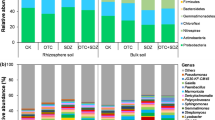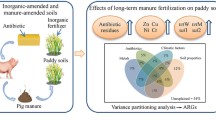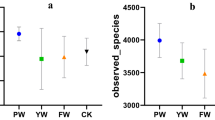Abstract
The responses of sulfonamides, sulfonamide-resistance genes (sul) and soil bacterial communities to different fertilization regimes were investigated by performing a field experiment using paddy soil with no fertilizer applied, chemical fertilizer applied, organic fertilizer applied, and combination of chemical and organic fertilizer applied. Applying organic fertilizer increased the bacterial community diversity and affected the bacterial community composition. Eutrophic bacteria (Bacteroidetes, Gemmatimonadetes, and Proteobacteria) were significantly enriched by applying organic fertilizer. It was also found organic fertilizer application increased sulfamethazine content and the relative abundances of sul1 and sul2 in the soil. In contrast, applying chemical fertilizer significantly increased the abundance of Nitrospirae, Parcubacteria, and Verrucomicrobia and caused no obvious changes on sul. Correlation analysis indicated that sul enrichment was associated with the increases in sulfamethazine content and potential hosts (e.g., Novosphingobium and Rhodoplanes) population. The potential ecological risks of antibiotics in paddy soil with organic fertilizer applied cannot be ignored.





Similar content being viewed by others
References
Bedard C, Knowles R (1989) Pysiology, biochemistry, and specific inhibitors of CH4, NH4+, and CO oxidation by methanotrophs and nitrifiers. Microbiol Rev 53(1):68–84
Bloem E, Albihn A, Elving J et al (2017) Contamination of organic nutrient sources with potentially toxic elements, antibiotics and pathogen microorganisms in relation to P fertilizer potential and treatment options for the production of sustainable fertilizers: a review. Sci Total Environ 607–608:225–242
Caporaso JG, Kuczynski J, Stombaugh J et al (2010) QIIME allows analysis of high-throughput community sequencing data. Nat Methods 7(5):335–336
Chadwick D, Wei J, Yan’an T et al (2015) Improving manure nutrient management towards sustainable agricultural intensification in China. Agric Ecosyst Environ 209:34–46
Chen QL, An XL, Li H et al (2017) Do manure-borne or indigenous soil microorganisms influence the spread of antibiotic resistance genes in manured soil? Soil Biol Biochem 114:229–237
Davis KE, Sangwan P, Janssen PH (2011) Acidobacteria, Rubrobacteridae and Chloroflexi are abundant among very slow-growing and mini-colony-forming soil bacteria. Environ Microbiol 13(3):798–805
Deng J, Zhang B, Xie J et al (2020) Diversity and functional prediction of microbial communities involved in the first aerobic bioreactor of coking wastewater treatment system. PLoS ONE 15(12):e0243748
Edgar RC (2010) Search and clustering orders of magnitude faster than BLAST. Bioinformatics 26(19):2460–2461
Fang H, Wang H, Cai L et al (2015) Prevalence of antibiotic resistance genes and bacterial pathogens in long-term manured greenhouse soils as revealed by metagenomic survey. Environ Sci Technol 49(2):1095–1104
Fierer N, Lauber CL, Ramirez KS et al (2012) Comparative metagenomic, phylogenetic and physiological analyses of soil microbial communities across nitrogen gradients. ISME J 6(5):1007–1017
Forsberg KJ, Reyes A, Wang B et al (2012) The shared antibiotic resistome of soil bacteria and human pathogens. Science 337(6098):1107–1111
Gu B, Ju X, Chang J et al (2015) Integrated reactive nitrogen budgets and future trends in China. Proc Natl Acad Sci U S A 112(28):8792–8797
Guo JH, Liu XJ, Zhang Y et al (2010) Significant acidification in major chinese croplands. Science 327(5968):1008–1010
Ji X, Shen Q, Liu F et al (2012) Antibiotic resistance gene abundances associated with antibiotics and heavy metals in animal manures and agricultural soils adjacent to feedlots in Shanghai; China. J Hazard Mater 235–236:178–185
Karkman A, Parnanen K, Larsson DGJ (2019) Fecal pollution can explain antibiotic resistance gene abundances in anthropogenically impacted environments. Nat Commun 10(1):80
Li H, Yang S, Semenov MV et al (2021) Temperature sensitivity of SOM decomposition is linked with a K-selected microbial community. Glob Chang Biol 27(12):2763–2779
Li X, Li B, Chen L et al (2022) Partial substitution of chemical fertilizer with organic fertilizer over seven years increases yields and restores soil bacterial community diversity in wheat–rice rotation. Eur J Agron 133:126445
Li XM, Chen QL, He C et al (2019) Organic carbon amendments affect the chemodiversity of soil dissolved organic matter and its associations with soil microbial communities. Environ Sci Technol 53(1):50–59
Lin H, Sun W, Zhang Z et al (2016) Effects of manure and mineral fertilization strategies on soil antibiotic resistance gene levels and microbial community in a paddy-upland rotation system. Environ Pollut 211:332–337
Liu J, Hua ZS, Chen LX et al (2014) Correlating microbial diversity patterns with geochemistry in an extreme and heterogeneous environment of mine tailings. Appl Environ Microbiol 80(12):3677–3686
Marti R, Scott A, Tien YC et al (2013) Impact of manure fertilization on the abundance of antibiotic-resistant bacteria and frequency of detection of antibiotic resistance genes in soil and on vegetables at harvest. Appl Environ Microbiol 79(18):5701–5709
Mori H, Maruyama F, Kato H et al (2014) Design and experimental application of a novel non-degenerate universal primer set that amplifies prokaryotic 16S rRNA genes with a low possibility to amplify eukaryotic rRNA genes. DNA Res 21(2):217–227
Schloss PD, Westcott SL, Ryabin T et al (2009) Introducing mothur: open-source, platform-independent, community-supported software for describing and comparing microbial communities. Appl Environ Microbiol 75(23):7537–7541
Sikora LJ, Enkiri NK (1999) Growth of tall fescue in compost/fertilizer blends. Soil Sci 164(1):62–69
Sun R, Zhang X-X, Guo X et al (2015) Bacterial diversity in soils subjected to long-term chemical fertilization can be more stably maintained with the addition of livestock manure than wheat straw. Soil Biol Biochem 88:9–18
Tang X, Lou C, Wang S et al (2015) Effects of long-term manure applications on the occurrence of antibiotics and antibiotic resistance genes (ARGs) in paddy soils: evidence from four field experiments in south of China. Soil Biol Biochem 90:179–187
Udikovic-Kolic N, Wichmann F, Broderick NA et al (2014) Bloom of resident antibiotic-resistant bacteria in soil following manure fertilization. Proc Natl Acad Sci U S A 111(42):15202–15207
Urra J, Alkorta I, Garbisu C (2019) Potential benefits and risks for Soil Health Derived from the Use of Organic amendments in Agriculture. Agronomy-Basel 9(9):542
van Elsas JD, Turner S, Bailey MJ (2003) Horizontal gene transfer in the phytosphere. New Phytol 157(3):525–537
Wang F, Xu M, Stedtfeld RD et al (2018) Long-term effect of different fertilization and Cropping Systems on the Soil Antibiotic Resistome. Environ Sci Technol 52(22):13037–13046
Wu J, Wang J, Li Z et al (2022) Antibiotics and antibiotic resistance genes in agricultural soils: a systematic analysis.Critical Reviews in Environmental Science and Technology1–18
Xu F, Du W, Carter LJ et al (2021a) Elevated CO2 concentration modifies the effects of organic fertilizer substitution on rice yield and soil ARGs. Sci Total Environ 754:141898
Xu F, Liu Y, Du W et al (2021b) Response of soil bacterial communities, antibiotic residuals, and crop yields to organic fertilizer substitution in North China under wheat–maize rotation. Sci Total Environ 785:147248
Xu M, Wang F, Sheng H et al (2021c) Does anaerobic condition play a more positive role in dissipation of antibiotic resistance genes in soil? Sci Total Environ 757:143737
Xu Y, Li H, Shao Z et al (2021d) Fate of antibiotic resistance genes in farmland soil applied with three different fertilizers during the growth cycle of pakchoi and after harvesting. J Environ Manage 289:112576
Zhang XY, Fang QC, Zhang T et al (2020) Benefits and trade-offs of replacing synthetic fertilizers by animal manures in crop production in China: a meta-analysis. Global Change Biol 26(2):888–900
Zhang Y, Cheng D, Zhang Y et al (2021) Soil type shapes the antibiotic resistome profiles of long-term manured soil. Sci Total Environ 786:147361
Zhao J, Ni T, Li Y et al (2014) Responses of bacterial communities in arable soils in a rice-wheat cropping system to different fertilizer regimes and sampling times. PLoS ONE 9(1):e85301
Zhu YG, Johnson TA, Su JQ et al (2013) Diverse and abundant antibiotic resistance genes in chinese swine farms. Proc Natl Acad Sci U S A 110(9):3435–3440
Acknowledgements
This work was supported by the National Natural Science Foundation of China (grant nos. 21876083 and 41571130061). We thank Gareth Thomas, PhD, from Liwen Bianji (Edanz) (https://www.liwenbianji.cn), for editing the language of a draft of this manuscript.
Author information
Authors and Affiliations
Corresponding author
Additional information
Publisher’s Note
Springer Nature remains neutral with regard to jurisdictional claims in published maps and institutional affiliations.
Rights and permissions
Springer Nature or its licensor (e.g. a society or other partner) holds exclusive rights to this article under a publishing agreement with the author(s) or other rightsholder(s); author self-archiving of the accepted manuscript version of this article is solely governed by the terms of such publishing agreement and applicable law.
About this article
Cite this article
Xu, F., Sun, G., Du, W. et al. Impacts of Chemical and Organic Fertilizers on the Bacterial Communities, Sulfonamides and Sulfonamide Resistance Genes in Paddy Soil Under Rice-Wheat Rotation. Bull Environ Contam Toxicol 110, 20 (2023). https://doi.org/10.1007/s00128-022-03642-z
Received:
Accepted:
Published:
DOI: https://doi.org/10.1007/s00128-022-03642-z




